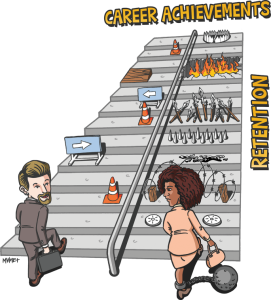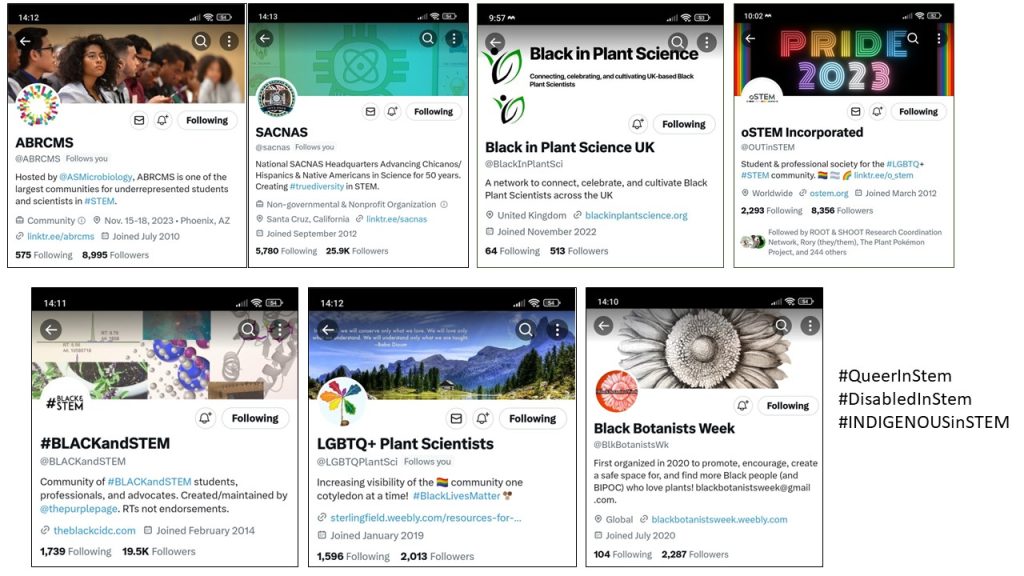On July 5, 2023, I participated in a workshop on the topic of social media and scientific communication, hosted by the Global Plant Council at the Society for Experimental Biology (SEB) conference in Edinburgh, Scotland.
I focused on two topics: how we can make our communications more accessible to all, and how social media provides opportunities to raise our cultural awareness and become better allies to people with marginalized identities, who are most likely to experience science as a hostile environment.
ROOT & SHOOT
I started by introducing the ROOT & SHOOT project, a five-year National Science Foundation (NSF) funded project granted to a research coordination network of seven plant science organizations. Specifically, I highlighted the aims of this program, which are to “remove barriers for individuals historically excluded from science based on gender, gender identity, disability status, sexual orientation, ethnicity, or race”. (The title of the project refers to our goals to “Root Out Oppression Together and SHare Our Outcomes Transparently”).
Accessibility in science communication
In June of this year, the US National Academies hosted a national summit on Disrupting Ableism and Advancing STEM as part of the project Beyond Compliance: Promoting the Success of People with Disabilities in the STEM Workforce. These programs demonstrate ways that the scientific culture is ableist, and access and highlight inclusion practices and policies that support and advance persons with disabilities in the STEM workforce.
If we are communicating about science in ways that are inaccessible, why are we surprised at the small proportion of people with disabilities who pursue careers in science?
I highlighted a few simple ways that we can all make our communications more accessible for people with visual impairments who use screen readers. As the name suggests, screen readers literally read aloud the contents of webpages, including social media sites.
Simple practices to improve accessibility for those using assistive technologies include using Alt Text (visual descriptions of images). You can read about what kinds of information to include in the alternative text field here, and for a more advanced tutorial, here.
 Screen readers also struggle with hashtags that are composed of strings of words, unless the first letter of each word is caplitalized. As an example, we looked at “#susanalbumparty” versus “SusanAlbumParty. (This format is camel case or Pascal case, read more at Accessible Social).
Screen readers also struggle with hashtags that are composed of strings of words, unless the first letter of each word is caplitalized. As an example, we looked at “#susanalbumparty” versus “SusanAlbumParty. (This format is camel case or Pascal case, read more at Accessible Social).
Finally, most screen readers read out the text description for an emoji (see https://www.emojipedia.org/nature/ to learn how your favorite emoji is named). Because screen readers read words where emojis appear, best practices call for putting them at the end of sentences so as not to interfere with comprehension, and not putting in too many which can be tedious to listen to (see the video below for an example of how a screen reader reads a sentence with interrupting emojis.)
Videos should be posted with closed captions. The benefits of closed captioning go well beyond the Deaf and hard-of-hearing communities, as many people scroll through social channels with their phone silenced. (As a rule, most efforts to make things more accessible benefit far more people than those the efforts were originally intended to benefit).
Finally, for scientific presentations, I strongly recommend that you edit any automatically generated closed captions; I use a tool called otter.ai (https://otter.ai/) and it takes me about four to eight hours to edit a one-hour scientific webinar.
You can find a huge array of further recommendations and resources through the DO-IT program (Disabilities, Opportunities, Internetworking, and Technology) at the University of Washington, including a video demonstration of how a screen reader navigates a webpage (https://www.washington.edu/doit/videos/index.php?vid=81).
Social media for cultural awareness
During the workshop we talked a lot about how social media provides opportunities to present ourselves and our work to the broader community. I have found it equally valuable as a way to learn about the experiences of people with social identities that differ from my own. Many people with identities that differ from the pervasive “professor” stereotype (white, male, cisgendered, heterosexual, non-disabled) experience a “hostile obstacle course” in their work environments (examples can be found here and here and here and here).
Eliminating many of these obstacles requires organizational and institutional changes, as detailed in a recent report from the National Academies, Advancing Antiracism, Diversity, Equity, and Inclusion in STEMM Organizations.
On the other hand, there is much that each of us can do as individuals to reduce the harm we cause others, starting by raising our awareness of the experiences of others. Both of the National Academy reports cited above are fantastic starting points if you’re ready to learn, and provide links to webinars and interactive websites as well as well-referenced reports.
First person accounts are powerful ways for all of us to learn how to avoid harming and begin to actively support our colleagues. However, as we discussed in the workshop, it is not appropriate for us to demand that someone share their trauma on demand. (And this request is frequently cited as a common microagression experienced by scientists with marginalized identities).
Instead, we can seek out the places where people choose to share their experiences, in books, blog posts, videos, and social media. Particularly through our own social media channels we can amplify and support these efforts. Here are a few accounts and hashtags I follow: @ABRCMS; @SACNAS; @BlackInPlantSci; @OUTinSTEM; @BLACKandSTEM; @LGBTQPlantSci; @BlkBotanistsWk; #QueerInStem; #DisabledInStem; #INDIGENOUSinSTEM.
Follow ROOT & SHOOT for resources and opportunities
ROOT & SHOOT has many ongoing projects and later this year we will be seeking participants to contribute to several working groups (with stipends!). I invite you to follow us on Twitter (@ROOTandShootRCN) and to sign up to receive our occasional email for announcements. Finally, we collect news and articles relevant to the goals of the project on this page, where you can find many additional resources.
Recommended Reading
Berhe, A.A., Barnes, R.T., Hastings, M.G. et al. Scientists from historically excluded groups face a hostile obstacle course. Nat. Geosci. 15, 2–4 (2022). https://doi.org/10.1038/s41561-021-00868-0
National Academies of Sciences, Engineering, and Medicine. 2023. Advancing Antiracism, Diversity, Equity, and Inclusion in STEMM Organizations: Beyond Broadening Participation. Washington, DC: The National Academies Press. https://doi.org/10.17226/26803.
National Academies of Sciences, Engineering, and Medicine. 2023. Disrupting Ableism and Advancing STEM: A National Leadership Summit. https://www.nationalacademies.org/event/06-05-2023/disrupting-ableism-and-advancing-stem-a-national-leadership-summit



0 Comments